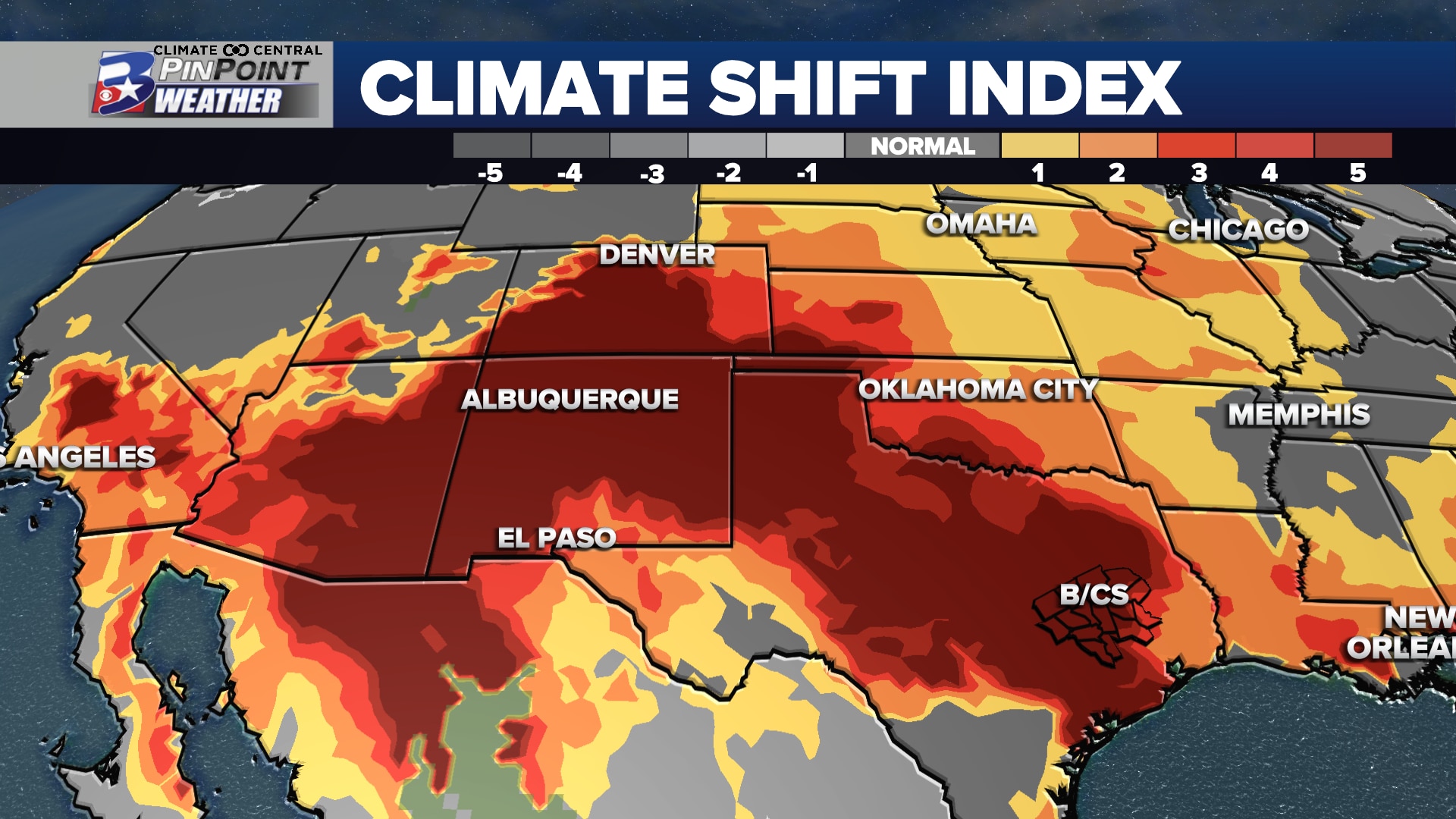REPORT: July’s global heatwave “virtually impossible” to occur without human-induced climate change
BRYAN, Texas (KBTX) – A combination of intense, compounding marine and land surface heatwaves in the Northern Hemisphere has put July 2023 on track to be the hottest month of July ever recorded on Earth. A new report released Tuesday by World Weather Attribution — an organization that performs most studies rapidly in the aftermath of extreme weather events to answer the question “What was the role of climate change in this event?” — the extreme heat in North America, Europe, and China this month has been made much more likely by man-made climate change.
Scientists from the World Weather Attribution initiative collaborated to assess to what extent human-induced climate change altered the likelihood and intensity of the extreme July heat in these three regions. Using published peer-reviewed methods, the organization analyzed how these impacts altered the likelihood and intensity of a period of 18-day average maximum temperatures over the most affected regions in the Western US, Texas, and Northern Mexico, a period of 7-day average maximum temperature over land in an area covering parts of Southern Europe, and a period of 14-day average maximum temperatures over the lowlands of China.
Figure 1: Maximum July temperatures averaged over the length of the heat events defined for this study (left-hand side) and the same but expressed in anomalies with respect to 1950-2023 (right-hand side). The first row shows the Western USA and Mexico, the second Southern Europe and the third row China.
The conclusion: the North American and Southern European heatwaves were “virtually impossible” without human-induced climate change. They found that heatwaves like these are no longer rare, due to warming caused by burning fossil fuels and other human activities. Events like these can now be expected approximately once every 15 years in North America, about once every 10 years in southern Europe, and approximately once every five years in China. The report also states that events like this will occur every 2 to 5 years in a world that is 2°C warmer than the preindustrial global climate.
This new study conducted both a statistical analysis using observations and a computer model analysis to compare today’s extreme heat to a climate without human-induced change.
Bryan-College Station is expected to end as the second hottest July in the Brazos Valley’s 141 years of record keeping, forecast to fall 0.6° short of the hottest on record. That number one spot is occupied by 2022 when the average temperature ended at 90.9°. This month’s heat has been a combination of over 15 consecutive triple-digit afternoons and what amounted to the second longest-running streak of 80°+ low temperatures on record. Using attribution science, much of June and July’s exceptional heat in the Brazos Valley has been calculated to be made four to five times more likely due to man-made climate change. As of July, 25th, 2023 to date — January 1st to the day — is the hottest of record locally.
MAIN FINDINGS:
Heatwaves are amongst the deadliest natural hazards with thousands of people dying from heat-related causes each year. However, the full impact of a heatwave is rarely known until weeks or months afterward, once death certificates are collected, or scientists can analyze excess deaths. Many places lack good record-keeping of heat-related deaths, therefore currently available global mortality figures are likely an underestimate.In line with what has been expected from past climate projections and IPCC reports these events are not rare anymore today. North America, Europe, and China have experienced heatwaves increasingly frequently over the last years as a result of warming caused by human activities, hence the current heat waves are not rare in today’s climate with an event like the currently expected approximately once every 15 years in the US/Mexico region, once every 10 years in Southern Europe, and once in 5 years for China.Without human-induced climate change, these heat events would however have been extremely rare. In China, it would have been about a 1 in 250-year event while maximum heat like in July 2023 would have been virtually impossible to occur in the US/Mexico region and Southern Europe if humans had not warmed the planet by burning fossil fuels.In all the regions a heatwave of the same likelihood as the one observed today would have been significantly cooler in a world without climate change. Similar to previous studies we found that the heatwaves defined above are 2.5°C warmer in Southern Europe, 2°C warmer in North America, and about 1°C in China in today’s climate than they would have been if it was not for human-induced climate change.Unless the world rapidly stops burning fossil fuels, these events will become even more common and the world will experience heatwaves that are even hotter and longer-lasting. A heatwave like the recent ones would occur every 2-5 years in a world that is 2°C warmer than the preindustrial climate.Heat action plans are increasingly being implemented across all three regions and there is evidence that they lead to reduced heat-related mortality. Furthermore, cities that have urban planning for extreme heat tend to be cooler and reduce the urban heat island effect. There is an urgent need for an accelerated roll-out of heat action plans in light of increasing vulnerability driven by the intersecting trends of climate change, population aging, and urbanization.
There’s a growing fear that some tipping point has been reached. Not only is the North Atlantic water temperature 4 standard deviations above the 1991-2020 mean, but the Antarctic sea ice coverage is 6.4 standard deviations below the 1991-2020 mean. A bona fide #ClimateEmergency. https://t.co/5R3CSCGToE
— Brian McNoldy (@BMcNoldy) July 24, 2023







